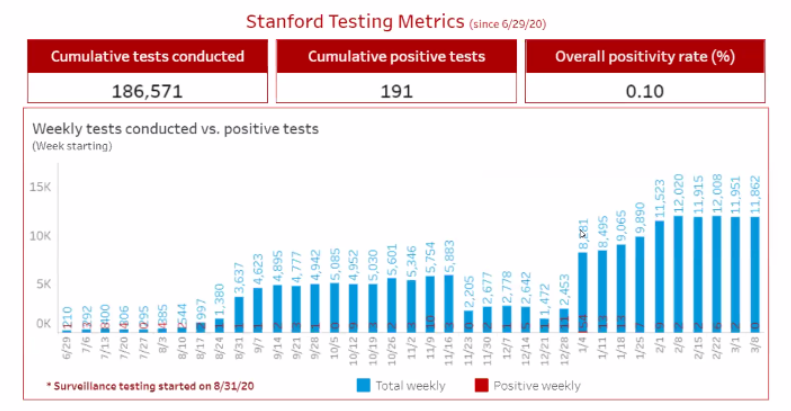
How Stanford’s COVID Analytics Helped It Navigate the Pandemic

Around this time last year, everyone and their brother was launching a dashboard for COVID analytics. Most of these were quite similar to one another: basic COVID data pulled from a handful of primary sources and parsed into slightly different levels of granularity, visualized locally or globally depending on the audience. At Stanford, however, the conversation was different: rather than using analytics for corporate social responsibility or awareness-raising, the university was focused directly on leveraging the power of data to protect its faculty, staff, and students.
At the HPC-AI Advisory Council’s annual Stanford Conference (once again held virtually), Raj Puri – Stanford’s director of strategic health initiatives and innovation – described their data journey. Puri, who himself has been going into the Stanford clinic every day since January 2020, quickly began to understand that the novel coronavirus wasn’t going away anytime soon. “It was really around February when I realized: it’s going to come to Stanford at some point,” he said. “What’re we gonna do about that, as an occupational health physician at Stanford taking care of employees and other folks?”
Working through Stanford’s Workplace Health Innovation Lab, Puri began developing a system called Health Check with three core objectives: first, to identify COVID cases at early onset via automated self-reporting; second, to decrease the time lag between initial notification by an employee and the occupational health department; and third, to automate notifications based on programmable logic, reducing the need for a one-on-one consultation with a physician before quarantine is recommended.
After a pilot through the Stanford Linear Accelerator group, the Health Check tool launched in late May, with all on-campus faculty, staff, and students required to fill out the survey daily. “You’re reporting your symptoms, you’re reporting the exposure you might have had, reporting any tests that you might have had, and travel,” Puri explained.
At first, of course, testing wasn’t widely available, so Health Check predominantly relied on self-reported symptoms to funnel responders into no-quarantine, one-day quarantine, three-day quarantine, seven-day quarantine, and 14-day quarantine buckets.
Once testing became more ubiquitous, Health Check was updated to automatically load results from a number of health data integration services. Stanford staff would use tools like badge access monitoring and Wi-Fi connection monitoring to ensure compliance with any recommended quarantines.
Over time, the features grew even more robust: They added contact tracing functionality, and, of course, once vaccinations began occurring, Health Check was updated to include vaccine self-reporting – including the brand of vaccine. All of this information was automatically loaded into a dashboard for the Workplace Health Innovation Lab, allowing the observers to easily monitor fluctuations in the percent of responders who had tested positive or were exhibiting more or less concerning symptoms.
By all appearances, the robust – and quick-moving – data-based approach paid dividends for Stanford. Except for a brief surge post-holidays in early January 2021, the campus’ students stayed under 13 weekly cases throughout the pandemic, logging 186,571 tests and just 191 positive tests for an overall positivity rate of 0.10% – keeping in mind, of course, that nearly 1 in 10 Californians have tested positive for COVID-19 at some point during the pandemic (staff, faculty and postdocs were slightly more prone to report positive COVID tests, with an overall rate of 0.15%). This more generalized data is available at the Stanford COVID Dashboard. Overall, Stanford has amalgamated the results of over 900,000 Health Check surveys – so far. “It’s proven to be the centerpiece for COVID prevention and mitigation at Stanford,” Puri concluded.
But COVID isn’t done yet, and neither are Puri and his colleagues. They’re already working to track variant data through Health Check in preparation for a greater emphasis on more contagious, evasive variants from Brazil, South Africa, and the United Kingdom. And, of course, the team isn’t planning on hanging up its spurs once the pandemic is over — rather, they’d like it to stick around to address future health or safety concerns.
“That’s the whole point of Health Check: to be ahead of the game automating everything,” Puri said. “In fact, I’d like to automate pretty much everything even when COVID goes away.”
To view the session from the Stanford Conference, click here.





























